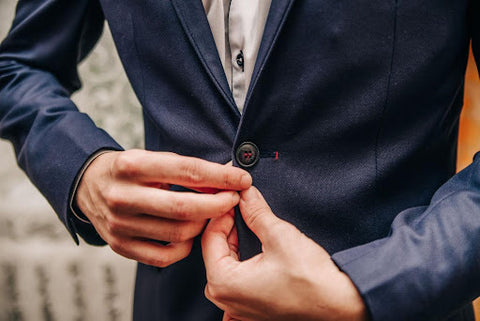
Those buttons lining your beautiful suit jacket aren't just there for show, but you can throw off the look of a suit by not knowing how to button them properly. Many men aren't aware of the suit jacket rules and regulations and prefer to close the buttons when standing and open them when sitting. While that does make a difference, perfecting your style means going all the way and knowing what to do with the variety afforded by single and double-breasted jackets. As we'll detail below, not knowing how to style your buttons can throw off a look, so let's explore the suit buttoning rules you need to know.
Why Does the Suit Buttoning Rules Matter?
Why on earth should you care about the way your buttons are fastened? Unfortunately, many men fall victim to this thought process; trust us, we get why. Most serve one purpose — to open or close a jacket or shirt. Throwing suit buttons into this category makes sense, but let's erase that from your mind immediately.
There are subtle and not-so-subtle differences that buttons can make that you might not have even considered. Think about the difference unzipping a jacket or leaving one button on a dress shirt open can make. Caring for the look of your buttons can help you stand out from the crowd of other guys unaware of the rules. Additionally, most modern suits are created assuming your bottom button will never be fastened. The last thing you should want to ruin is a beautifully cut jacket because you didn't follow the rules.
Single-Breasted Suit Jackets
Single-breasted suit jackets are one of the most common ways to wear a suit, with a column of one, two, or three buttons lining the center of the jacket. With each additional button comes a new rule to remember, but don't worry, they aren't too difficult to understand. Understanding the differences takes your suit game to a whole new level.
Single Button Suits
Let's start with this; single button suits must always be buttoned when standing up. Always. A hanging jacket gives off a much too casual look and ruins the entire suit aura. These jackets are usually a bit longer than the others, so fastening the button is a great way to avoid creases and keep the suit looking as proportional as ever.
Two Button Suits
Two-button suits rely on one relatively simple rule to remember — never leave the bottom button undone. Not only will you look unsure of what you're doing, but the bottom button creates a larger, billowing silhouette that throws off your entire look. Instead of balance, even the highest quality suits will look less than stellar.
Three Button Suits
For single-breasted three-button suits, you're offered more versatility when it comes to leaving buttons open or closed. The rules usually state to leave the top button optional, with the middle button always closed and the bottom button never closed. On these suits, the lower button usually restricts motion to an uncomfortable degree. Most top buttons can be left unbuttoned, especially when it interferes with the lapels' natural fold.
Double-Breasted Suit Jackets
Double-breasted jackets are a bit more complex than their companion, but not all buttons are functional, making it easier to keep track of what to do. Most of the time, every working button on the jacket should be buttoned up while fastening the bottom button can be optional.
Sometimes you can break the rules a bit, but only on specific button types. 4x1 And 6x1 suits should have all their buttons fastened, and the top buttons should never be undone. If you're still unsure what to do with your suit buttons, check with the best tailor in Pittsburgh or someone in the know of all the suit jacket rules. And one more thing: never unbutton all the buttons on a double-breasted jacket, even when sitting down.
Commonwealth Proper Defines Elegance — No Matter What Suit You Choose
At Commonwealth Proper, we define elegance and luxury by the quality of our offerings. We have redefined the city of Philadelphia by providing a means to acquire luxury from some of the best suit tailors in the country. With a wide variety of made-to-measure suits in Philadelphia and other luxury attire, anything you get from Commonwealth Proper will exude elegance for years to come. Pair your newfound suit buttoning knowledge with luxury fabrics by contacting us today or visiting us at one of our Philadelphia, Pittsburgh, or Atlanta locations.
